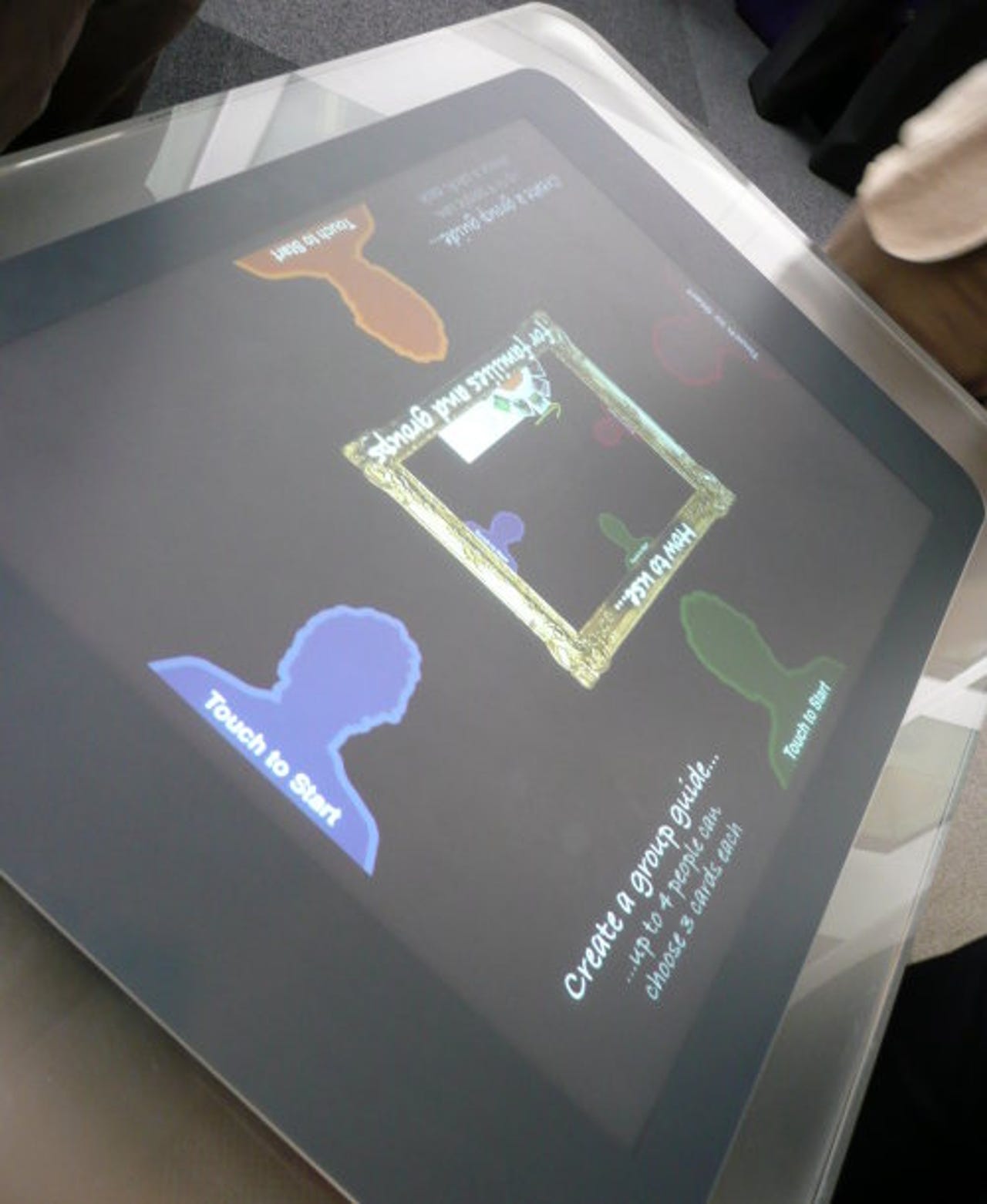Photos: Can tech change your behaviour? The Open University investigates


Open University Surface touchscreen Group Tour app
From pervasive to persuasive...
The Jennie Lee Research Laboratories at the Open University's (OU) Milton Keynes campus is home to a number of research projects exploring how a variety of technologies can be used to shape and change human behaviour. This week, silicon.com got to take a look at some of them.
Pictured above is a PhD project utilising Microsoft's Surface touchscreen table PC to run a collaborative tour guide application, enabling up to four people to stand around the table together and build an itinerary for tourists visiting the city of Cambridge.
Its creator, PhD student Richard Morris, wanted to build an interface that allows multiple people to interact with the application at once.
The table was demoed during a tour of the OU's Pervasive Interaction Lab, which takes an interdisciplinary approach to human computer interaction research. A team of computer scientists, cognitive scientists, designers and psychologists work together in the lab on projects that explore how technology can be used to augment and influence everyday human behaviour, and help learning and work activites.
Open University MusicJacket project
This project, called MusicJacket, aims to help people who are learning to play the violin maintain the correct posture and bow length while they play.
The jacket contains a variety of motion-capture sensors to track the position of the violin and the bow trajectory, with data transferred wirelessly to a laptop for processing. The jacket then gives its wearer feedback in the form of vibrations to indicate when they need to adjust their position.
The researchers have taken the jacket into schools to study whether children were able to use it to improve their violin technique. "The very small children who weren't able to do the bowing used it very well to help hold their violin up," said PhD student Rose Johnson, who is working on the project. "With the older children that were more focused on bowing, we saw things like they would glance down at their bow more often and be much more aware of where their bow was."
Johnson is now looking at building more lightweight systems that use microcontrollers to do the processing, doing away with the need for a laptop. She demoed a second prototype built on two sweatbands worn on the bowing arm which uses vibrations to indicate when full bowing length has been achieved.
Open University shopping air miles scanner prototype
This device aims to change shopping behaviour by encouraging people to choose what to buy based on how many air-freight miles are needed to deliver it to the shop.
The prototype, designed to sit on a shopping trolley, contains a barcode scanner. When the shopper scans an item, the system consults a database of product manufacturing locations and then uses the strip of lights - which run from green, meaning low mileage, to red, meaning high mileage - to indicate whether it's a costly item to buy in terms of the amount of air-freight associated with the product.
"For us, what's interesting is, is information displayed in this format going to make people change their behaviour?" said one of the project's researchers.
Open University touchscreen collaboration sheep game
Here, a touchscreen has been turned into a collaborative game designed to teach players about managing shared resources.
Players touch the screen to generate a sheep and let it roam the table grazing on grass. The apparent aim of the game is to create jumpers, which require sheep to supply the wool. However, if too many sheep are created, the grass cannot grow back quickly enough to sustain the animals and they start to die.
"Naively, one would think the best strategy [to make lots of jumpers] is to create lots of sheep, and then they would make lots and lots of jumpers," said the researcher. "But eventually, if you have too many sheep in the game, everyone will lose because there will be no more grass at all."
The researchers are using the interface to study what sort of information can make players more or less co-operative or competitive.
Open University Discovery Project
Another touchscreen tabletop is used in this initiative, called The Discovery Project, which is part of a wider research project called 'Out there, in here'.
The OU researchers are exploring how a variety of technologies including GPS, mobile phones, live video feeds and digital maps can be used to create a collaborative system that enables field teams and office-based teams to work together to gather and research data.
Open University Discovery Project
The researchers have trialled the system with community groups in Cambridge to explore a local cemetery.
Teams were divided into an indoor and an outdoor group. The outdoor group were given mobile phones and asked to seek out particular data, such as individual graves, photographing and labelling what they found - as pictured above.
This data was then shared with the indoor group who were participating in the investigation by accessing the internet via tablets and laptops, and also using the Surface touchscreen tabletop. The indoor group could see where members of the outdoor group were in the cemetery by watching their locations being mapped on to a live video feed of the location.
Open University Discovery Project
Here, the table is used to display a document that contains information relating to people buried in the cemetery.
Thanks to the system, indoor groups can gain access to relevant archive information which they can then use to direct the investigation of the outdoor field group, said a researcher working on the project. "There's something for everyone to do," he said.
The OU has used the system with some of its geology students, allowing field trippers to get on with collecting rock samples with students not on the trip able to analyse the data, helping to build up "an immediate picture of the data".
"Taking people out to a field site can be expensive," noted the researcher. "What you can do with this is have a group of people indoors who are getting an interesting experience of being connected to a live event but they're doing the information seeking and analysis... that wouldn't necessarily be the best use of time [for the outdoor group]."
The Surface touchscreen tabletop acts as a high-tech update on the historical 'mission control' table, he added, which would typically have had paper maps on it.
Open University ambient floor lighting project
This may look like institutional carpet tiling that has seen better days - but look closely and you'll see several twinkling lights shining through the carpet, and leading off in a particular direction.
The lights are triggered when a person walks into the OU's Jennie Lee building and steps on a concealed motion-sensing board. The aim of the project was to try to influence people's behaviour by encouraging them to take the stairs, rather than the lift, according to PhD student Nadia Pantidi.
"We wanted something that blends in with the building, that's not obtrusive... but still hints you towards some behavioural change," she said.
Open University stairs vs lift project
Here, a second project also aims to nudge people in the building to take the more environmentally friendly option of walking up the stairs - this time using a more obvious signal: an installation of coloured balls hanging in the atrium. The orange balls represent the the stairs, the grey balls signify lift usage, while the height of the balls indicates how popular each method currently is.
Open University stairs vs lift project
The installation refreshes every 30 minutes depending on the data collected by people stepping on touch-pads next to sets of stairs and lifts in the building.
After six months of running the carpet lights and the coloured balls, the number of people using the stairs had increased significantly, according to Pantidi. "There's lots of discussion about nudging technologies - whether it's ethical, whether it's not - but people still get to choose," she said.
"Most people when we asked them, 'Do you think this has changed your behaviour?', they said no. But the data showed that it had actually done that," she added. "People were chatting a lot about it... We observed people telling other people off for using the lift - 'You're representing a grey ball right now!'."